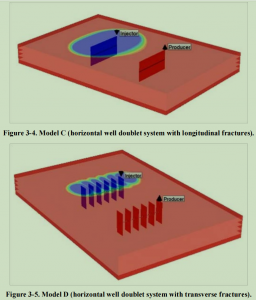Sedimentary Geothermal Feasibility Study
Abstract
The objective of this project is to analyze the feasibility of commercial geothermal projects using numerical reservoir simulation, considering a sedimentary reservoir with low permeability that requires productivity enhancement. A commercial thermal reservoir simulator (STARS, from Computer Modeling Group, CMG) is used in this work for numerical modeling. In the first stage of this project (FY14), a hypothetical numerical reservoir model was developed, and validated against an analytical solution. The following model parameters were considered to obtain an acceptable match between the numerical and analytical solutions: grid block size, time step and reservoir areal dimensions; the latter related to boundary effects on the numerical solution. Systematic model runs showed that insufficient grid sizing generates numerical dispersion that causes the numerical model to underestimate the thermal breakthrough time compared to the analytic model. As grid sizing is decreased, the model results converge on a solution. Likewise, insufficient reservoir model area introduces boundary effects in the numerical solution that cause the model results to differ from the analytical solution.
In this report summarizing FY15 work, a more realistic geologic model is considered, developed using actual well log and core data from the selected target sedimentary formation. In this report we present the process of reservoir characterization of the Lyons sandstone formation of the Wattenberg field in Colorado. The reservoir characterization involved the pre-processing and analysis of 14 well logs, obtained from the Colorado Oil and Gas Conservation Commission website that were drilled through the Lyons formation. A geostatistical approach was used, based on the well log data, to construct a reservoir model with geologic features, such as, geometry (tops, bottom, and thickness), rock properties (i.e., porosity), and temperature. In addition, core measurement data was used to build a correlation between porosity and permeability. Three models (i.e., base case, object-based model, and dual permeability model) are presented to show how different geologic features affect the thermal behavior of the sedimentary geothermal system.


